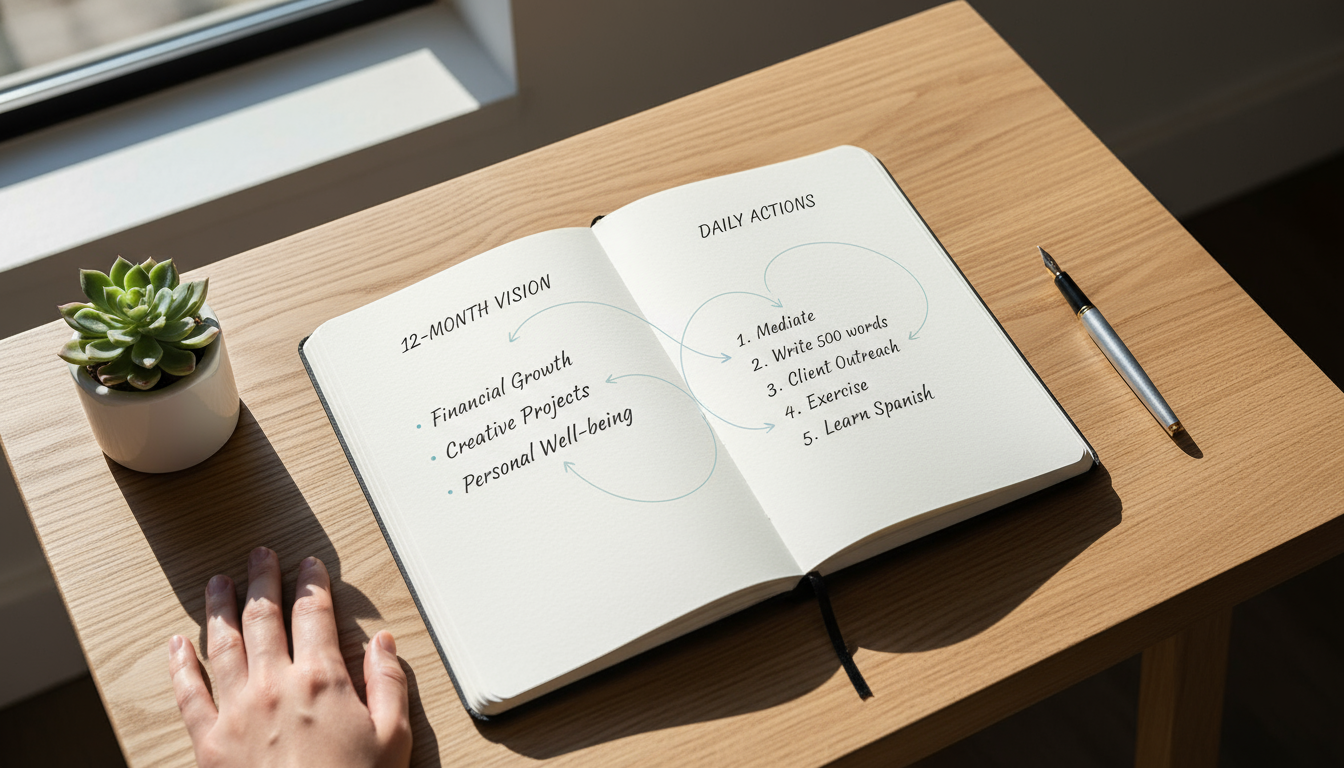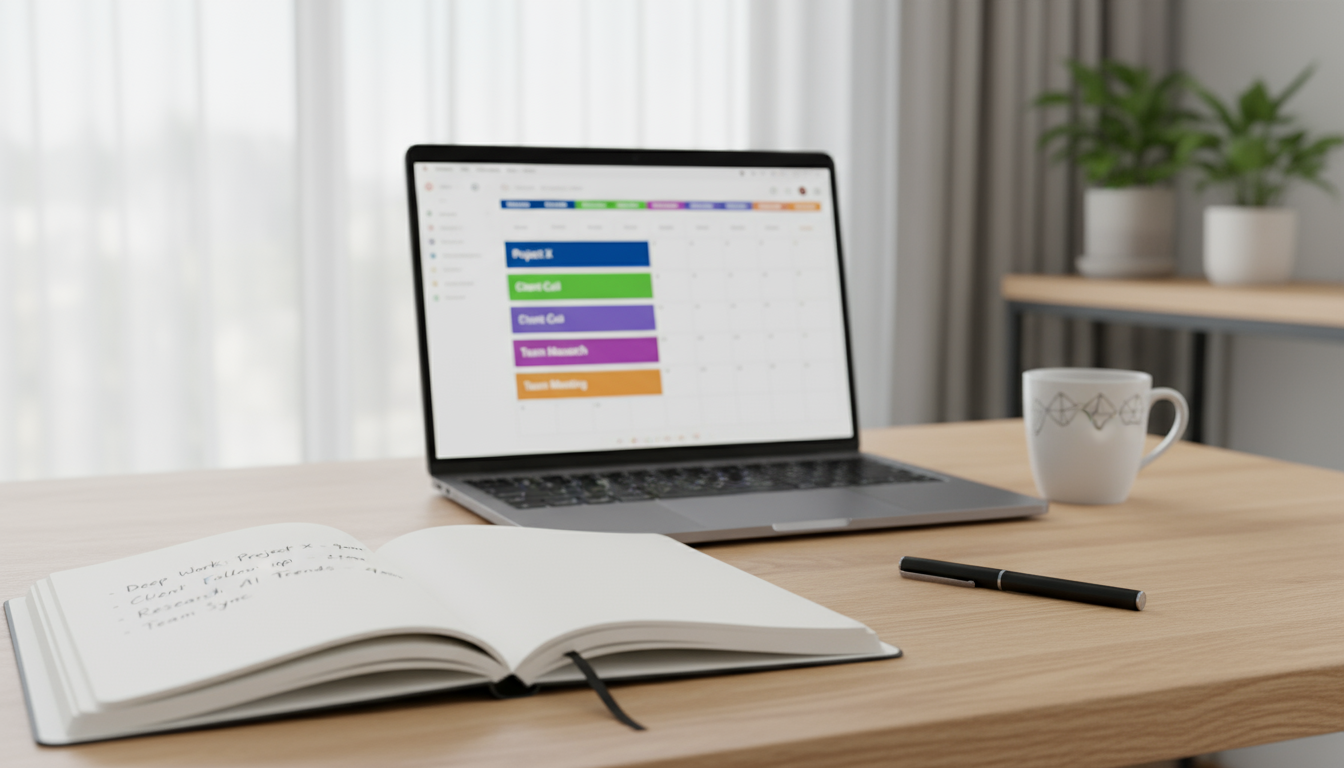
We’ve all been there. On a burst of motivation, you declare a new goal. “I’m going to get in shape.” “I want to advance my career.” “This year, I’ll finally learn Spanish.” These intentions are admirable, but they often have one fatal flaw: they are vague, formless wishes. They lack the teeth of a concrete plan. Days turn into weeks, and that initial spark of motivation fades, leaving the goal as a distant, fuzzy idea on the horizon. The problem isn’t a lack of desire; it’s a lack of clarity and a system for consistent action.
What if you could bridge the enormous gap between your big ambitions and your daily actions? What if you had a tool that not only clarified your targets but also created a reliable rhythm of execution and review? That tool isn’t a complex app or an expensive course. It’s a simple, powerful, and timeless practice: journaling. But not just any kind of journaling. We’re not talking about a “dear diary” log of your feelings. We’re talking about a structured, strategic journaling habit designed specifically for goal achievement.
At TheFocusedMethod.com, we believe that follow-through is a skill, not an innate talent. This article will guide you through a practical journaling system that transforms your abstract goals into a clear, actionable roadmap. You will learn how to translate a grand vision into quarterly objectives, weekly priorities, and daily tasks. We will demystify concepts like OKRs and leading indicators, giving you the vocabulary and the framework to measure what truly matters. This is the simple journaling habit that will finally help you achieve your most important personal goals.
📚 Table of Contents
- The System: From 12-Month Vision to Daily Action
- Step 1: Define Your 12-Month Vision
- Step 2: Set Your 90-Day Themes with OKRs
- Step 3: Plan Your Weekly Focus with Leading Indicators
- Step 4: Execute with a Daily Action Journal
- How to Measure What Matters (Without Drowning in Data)
- Planning for Reality: Time, Energy, and Constraints
- From Journal to Calendar: The Power of Time Blocking
- Using Checkpoints to Adjust Your Course
- Designing Constraint-Aware Plans
- Worked Examples: Bringing the Method to Life
- Frequently Asked Questions (FAQ)
- What if I have too many goals? How do I choose?
- My goals seem to conflict with each other. What should I do?
- How do I stay motivated when I don’t feel like it?
- Some of my goals are hard to measure. How do I create Key Results?
- Your First Step Starts Today

The System: From 12-Month Vision to Daily Action
The power of this journaling method lies in its ability to create a clear hierarchy of priorities. It connects the person you want to become in the long term with the person who sits down to work today. It’s a cascading system that brings your highest aspirations down to earth. Let’s break it down, step by step.

Step 1: Define Your 12-Month Vision
Before you can plan your journey, you need to know your destination. Forget about specific, measurable goals for a moment. Start with a vision. Close your eyes and imagine it’s one year from today. You’ve had a fantastically successful year in one key area of your life. What does that look like? What have you accomplished? How do you feel? Write this down in your journal in clear, inspiring prose. This isn’t about metrics yet; it’s about the qualitative outcome. For example, a vision might be: “In 12 months, I am a confident professional who has successfully transitioned into a new industry, feeling challenged and fulfilled in my new role.” This vision is your North Star. It provides the essential “why” that will fuel you when motivation wanes.

Step 2: Set Your 90-Day Themes with OKRs
A year is a long time, and it’s easy to lose focus. The solution is to break your 12-month vision into 90-day (or quarterly) sprints. Each quarter, you will choose one major theme or objective that moves you significantly closer to your vision. This is where we introduce a powerful goal-setting framework used by companies like Google: Objectives and Key Results (OKRs).
An Objective is a qualitative, memorable, and inspirational statement of what you want to achieve. It’s the theme for the quarter. A great objective should make you feel a little excited and slightly uncomfortable.
Key Results are the quantitative metrics that prove you’ve achieved your objective. They are specific, measurable, and verifiable. If an objective is the destination, key results are the signposts that tell you you’re on the right path. You should have 2-3 key results for each objective.
Let’s translate our career pivot vision into a Q1 OKR:
Objective: Build the foundational skills and network needed to be a credible candidate in my new target industry.
Key Results:
1. Complete the ‘Data Science for Beginners’ certification course with a final score of 90% or higher.
2. Conduct 10 informational interviews with professionals currently working in data science.
3. Build and publish one portfolio project analyzing a public dataset.
This OKR structure immediately transforms a vague desire into a concrete, measurable mission for the next 90 days. You write this OKR at the beginning of a new section in your journal.

Step 3: Plan Your Weekly Focus with Leading Indicators
With a 90-day mission, you now need to translate it into weekly action. This is where most goal-setting systems fall apart. We tend to focus on the outcome, the final result, which can feel distant and overwhelming. The key is to shift your focus to the actions you can control this week.
To do this, we need to understand the difference between lagging indicators and leading indicators. A lagging indicator measures an outcome that has already happened. Your Key Results (like completing a course) are lagging indicators. A leading indicator measures the inputs or actions that you believe will drive that outcome. These are the things you have direct control over every day.
This is also known as focusing on input goals versus output goals. An output goal is the result (e.g., lose 10 pounds). An input goal is the process (e.g., consume 2,000 calories per day and exercise 3 times per week). Your journal is where you track the inputs.
At the start of each week, look at your quarterly OKR and ask: “What are the most important actions I can take this week to make progress on my Key Results?”
For our career pivot example, a weekly focus might be:
“This week, my focus is to complete modules 3 and 4 of my course, reach out to 5 new people for interviews, and spend 3 hours outlining my portfolio project.”
You write this focus at the top of a new page in your journal every Sunday evening or Monday morning. It becomes your weekly charter.

Step 4: Execute with a Daily Action Journal
This is where the rubber meets the road. The daily journaling habit is incredibly simple and takes less than five minutes. Each morning, you will write down the 1-3 most important actions for the day that directly support your weekly focus. These are not your entire to-do list; they are your goal-oriented priorities.
A daily journal entry might look like this:
Morning (2 minutes):
Today’s Goal Actions:
1. Watch and take notes on course module 3.
2. Draft and send connection requests to 2 professionals on LinkedIn.
Evening (3 minutes):
At the end of the day, you return to your journal for a quick reflection. This isn’t for self-judgment; it’s for learning and adjustment.
Reflection: Completed module 3; it was tougher than I thought. I sent the connection requests. Tomorrow, I need to block out a specific time for module 4, as today felt a bit rushed.
This daily loop of planning and reflecting is the engine of your progress. It keeps your goal top-of-mind and creates a powerful feedback mechanism for continuous improvement.
![]()
How to Measure What Matters (Without Drowning in Data)
The purpose of measuring your progress is not to be perfect, but to be informed. Your journal is your personal dataset for what’s working and what isn’t. The key is to keep it simple and sustainable.

Choose Simple, Binary Metrics
The most effective metrics are often the simplest. For your daily actions, the best metric is often binary: Did I do it? Yes or No. You don’t need a complicated scoring system. The goal is to build consistency. A simple checkmark next to your completed actions in your journal is incredibly satisfying and visually represents your momentum.
For your weekly focus and quarterly Key Results, you are tracking progress toward a number. For instance, if your Key Result is to conduct 10 informational interviews, and you’ve done 2, you are 20% complete. This straightforward tracking prevents you from getting lost in complex spreadsheets. Your journal is the single source of truth.

Establish a Review Cadence
Consistency comes from rhythm. This system has a built-in review cadence that keeps you on track:
- The Daily Check-in (5 Minutes): As described above, you plan in the morning and reflect in the evening. This is your micro-adjustment loop.
- The Weekly Review (15-20 Minutes): Every Friday or Sunday, review your journal entries for the week. Celebrate your wins. Tally your progress against your weekly focus. Most importantly, identify what went well and what obstacles you faced. Use these insights to set a realistic and effective focus for the upcoming week.
- The Quarterly Reset (1-2 Hours): At the end of each 90-day cycle, conduct a deeper review. Look at your journal as a whole. How much progress did you make on your OKRs? It’s okay if you only hit 70-80%; that often means you set an ambitious goal. What did you learn about yourself and your process? Based on this review, set your OKR for the next quarter, ensuring it aligns with your 12-month vision.

How to Handle Slip-Ups and Missed Days
You will miss a day. You will have an off-week. This is not a failure; it is an inevitability. How you respond is what matters. Your journal is a tool for compassion, not criticism. When you miss a goal, use your evening reflection to ask curious, non-judgmental questions:
“I didn’t do my planned coding session today. Why? I was exhausted after a long day at work. What could I change? Maybe a 30-minute session in the morning before work would be more realistic on busy days.”
A slip-up is simply data. It’s your system telling you that something needs to be adjusted. Maybe the goal was too big, the timing was wrong, or an external factor intervened. Use the information to make a better plan for tomorrow. The goal is not a perfect streak; the goal is to get back on track quickly and learn from the experience. The psychological benefits of this self-compassionate approach are well-documented and crucial for long-term persistence, a concept supported by research from institutions like the American Psychological Association.

Planning for Reality: Time, Energy, and Constraints
A goal without a plan is just a wish, and a plan that ignores reality is a fantasy. Your journaling habit becomes exponentially more powerful when you connect it to the practical constraints of your daily life, specifically your time and energy.

From Journal to Calendar: The Power of Time Blocking
Your daily journal entry tells you what to do. Your calendar tells you when you will do it. After writing your 1-3 goal actions for the day, immediately open your calendar and schedule appointments with yourself to complete them. This practice, often called time blocking, is a game-changer.
If one of your actions is “Spend 1 hour working on portfolio project,” find a specific 60-minute slot in your day and block it off. Label it. Protect it like you would a meeting with your boss. This simple act transforms a floating intention into a concrete commitment. It forces you to confront the reality of your schedule and make intentional trade-offs. You can no longer say you “don’t have time”; you must now acknowledge that you are choosing to prioritize something else.

Using Checkpoints to Adjust Your Course
Your weekly and quarterly reviews are not just for measuring progress; they are critical planning checkpoints. During your weekly review, you might notice a recurring pattern: you consistently fail to complete your third goal action of the day. This is a sign that your daily plan is too ambitious for your current reality. The plan needs to change. For the next week, you might decide to commit to only two goal actions per day, or to make the third one significantly smaller.
Similarly, your quarterly review is a chance to make major course corrections. Perhaps you realize the Key Result you set is no longer relevant, or that you’ve severely underestimated the time required. That’s okay. You can adjust your OKRs for the next quarter based on the rich data you’ve collected in your journal. This adaptive planning process is what separates those who achieve their goals from those who stick rigidly to a flawed initial plan.

Designing Constraint-Aware Plans
We all operate under constraints: a demanding job, family commitments, limited financial resources, or fluctuating energy levels. Acknowledging these constraints is not an excuse; it’s a strategic imperative. Your journal is the perfect place to get honest about your limitations.
When setting your weekly focus, ask yourself: “Given my energy levels and my other commitments this week, what is a realistic amount of progress I can make?” It is far better to set a smaller, achievable goal and build momentum than to set a huge, inspiring goal that you have no real chance of accomplishing. A string of small, consistent wins, documented in your journal, builds the confidence and motivation needed to tackle larger challenges over time. Your plan should be built for the life you actually have, not the one you wish you had.

Worked Examples: Bringing the Method to Life
Theory is one thing, but practice is another. Let’s walk through two detailed scenarios to see how this journaling system works in the real world.

Scenario 1: The Fitness Goal
Maria’s 12-Month Vision: “In one year, I feel strong, energetic, and healthy. I have completed my first 10k race and have built a consistent fitness routine that I genuinely enjoy and can sustain for the long term. I no longer see exercise as a chore, but as a vital part of my life.”
Her Q1 OKR:
Objective: Build the foundational habit of consistent, injury-free running.
Key Results:
1. Run 3 times per week, every week, for 12 consecutive weeks.
2. Increase my longest run from 1 mile to 3 miles (5k).
3. Complete 2 strength training sessions per week to support my running.
A Sample Week 4 in Maria’s Journal:
At the start of the week, she writes her weekly focus: “This week, my focus is to complete my three scheduled runs (2 short, 1 long of 1.5 miles), do my two strength sessions, and foam roll after every run.”
Tuesday’s Daily Journal Entry:
Morning Plan:
1. Complete my 20-minute strength training session before work.
2. Pack my gym bag for tomorrow morning’s run.
Evening Reflection:
I got the strength session done! It felt great. Having my bag packed for tomorrow makes the morning run feel so much more achievable. I feel prepared and in control.
Through this simple process, Maria isn’t just “trying to get fit.” She is executing a precise plan, tracking her input goals (the workouts), and making small adjustments to ensure her success. Her journal becomes a record of her commitment and growing strength.

Scenario 2: The Learning Goal
David’s 12-Month Vision: “One year from now, I am conversationally fluent in Spanish. I can confidently navigate a trip to a Spanish-speaking country, holding conversations about daily life, food, and travel. I feel a deep sense of accomplishment and a new connection to a different culture.”
His Q2 OKR:
Objective: Master foundational grammar and build a core vocabulary of 500 words.
Key Results:
1. Complete all A1 level lessons in my language app.
2. Create and review 500 digital flashcards, achieving 90% recall.
3. Have one 30-minute conversation with a language tutor each week.
A Sample Week 7 in David’s Journal:
His weekly focus is: “This week, I will complete 5 new lessons in the app, add 40 new words to my flashcard deck, and prepare a list of questions for my Saturday tutoring session.”
Thursday’s Daily Journal Entry:
Morning Plan:
1. Do one 20-minute language lesson during my commute.
2. Review my flashcard deck for 10 minutes during my lunch break.
Evening Reflection:
Commute lesson was perfect. I was tired at lunch and almost skipped the flashcards, but I did it anyway. I notice I’m starting to recognize words without consciously translating them. My tutor session is on Saturday; I need to remember to write down my questions tomorrow.
David’s journal breaks the overwhelming goal of “learning Spanish” into small, daily, manageable inputs. It helps him see the progress that is often invisible day-to-day and keeps him engaged in the process, not just the distant outcome.

Frequently Asked Questions (FAQ)
Even the best systems can bring up questions. Here are answers to some common challenges you might face when implementing a goal-achievement journal.
What if I have too many goals? How do I choose?
This is a common and important challenge. The power of the OKR system is that it forces you to prioritize. You should only have 1-2 major Objectives per quarter. An objective should be significant enough that it requires real focus. If you have five big goals, you really have none. Your journal is a great place for a “Someday/Maybe” list. When other exciting ideas pop up, write them down in the back of your journal to revisit during your next quarterly reset. This honors the idea without derailing your current focus. Choose the one goal that, if achieved, would have the most positive impact on your life over the next 90 days.
My goals seem to conflict with each other. What should I do?
Conflicting priorities are a sign of a lack of clarity in your overarching vision. For example, a goal to “aggressively save for a house down payment” might conflict with a goal to “travel to three new countries this year.” The 12-month visioning exercise is crucial here. What is more important to you right now? There is no right answer, only the answer that is right for you. You may need to sequence your goals. Perhaps one quarter is focused on a financial Key Result, and the next quarter is focused on planning a more budget-conscious trip. Your journal helps you make these trade-offs consciously, rather than feeling pulled in two directions at once.
How do I stay motivated when I don’t feel like it?
Motivation is fleeting; systems are reliable. This journaling habit is designed for the days you don’t feel motivated. First, the habit itself is small. Committing to a two-minute journal entry is easy, even on a bad day. Second, your daily actions should be broken down into ridiculously small steps. Instead of “write chapter one,” your action could be “write one paragraph.” This makes it easier to get started. Finally, use your journal to reconnect with your “why.” Reread your 12-month vision. Look back at the last few weeks of entries and see the progress you’ve already made. This act of reviewing past wins is often the spark needed to take the next small step.
Some of my goals are hard to measure. How do I create Key Results?
This often happens with qualitative goals like “be more confident” or “reduce stress.” The key is to translate these feelings into observable behaviors or actions. What would a more confident person do? What actions would a less stressed person take? Instead of a Key Result like “Feel 50% less stressed,” try something like “Meditate for 10 minutes, 3 times per week” or “End my workday by 6 PM every day for a month.” By focusing on the inputs (actions) that you believe will lead to the desired output (feeling), you create a measurable and actionable goal. Your journal then becomes the place to track not only the action, but also its effect on your subjective well-being. For a deeper understanding of behavior change, resources from the National Institutes of Health can provide valuable insights.

Your First Step Starts Today
You have now learned a complete system for turning vague ambitions into tangible achievements. We’ve moved from a grand 12-month vision down to the concrete, two-minute journaling habit you can perform every day. This process of cascading clarity—from vision to objective to weekly focus to daily action—is the engine of follow-through. It creates a powerful feedback loop where your daily efforts build momentum, and your regular reviews ensure you stay on the right path.
This isn’t about perfection. It’s about progress. It’s about building a compassionate, data-driven relationship with your own goals. Your journal is your private coach, your data scientist, and your biggest cheerleader, all in one. It’s a space to be honest, to learn from your missteps, and to celebrate the small, consistent wins that ultimately lead to extraordinary results.
Information alone doesn’t create change; action does. The gap between reading this article and achieving your goals can be closed by a few simple decisions you make right now. Don’t wait for the new year, a new month, or even next Monday. Start today.
Here are three decisions to make right now:
1. Choose your focus. Pick one, and only one, major area of your life you want to transform over the next 90 days. Career? Health? A skill? A relationship? Write it down.
2. Draft your first OKR. Based on that focus area, write a single, inspiring Objective. Then, brainstorm 2-3 specific, measurable Key Results that will prove you’ve achieved it. Don’t worry about getting it perfect; you can refine it later.
3. Write your first journal entry. Grab a notebook or open a blank document. Write down your OKR at the top. Then, write down the single most important action you can take tomorrow to move toward one of your Key Results. That’s it. You’ve begun.
By taking these small steps, you are activating the system and starting the flywheel of progress. You are choosing clarity over ambiguity, and action over intention. This simple journaling habit is the bridge to the future you envision. Go build it.
Disclaimer: The information provided in this article is for informational purposes only and is not intended as a substitute for professional medical, financial, or legal advice. Always seek the advice of a qualified professional with any questions you may have.





